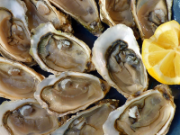Vibrios are bacteria that are found in seafood and fish. Infections with vibrios can lead to diarrhoeal diseases in humans. Climate change and the associated warming of the seas could make them occur more frequently in the future. The FSVO is studying fish and seafood to take stock of this situation.

Vibrios as pathogens
Vibrios are bacteria that live in salt water. They are found throughout the world in marine waters and estuaries (brackish water and lagoons). The consumption of contaminated raw fish or insufficiently cooked seafood (e.g. oysters) may lead to an infection of the gastrointestinal tract by the vibrios. Typical symptoms are spasmodic abdominal pains, nausea, vomiting and watery diarrhoea. The course is mostly rather mild, but in rare serious cases may bring about septicaemia (blood poisoning) that may possibly even be fatal.
The majority of food-borne infections with vibrios are caused by the three species Vibrio parahaemolyticus, V. cholerae and V. vulnificus. Such infections are rather rare in Switzerland, but in many Asian and American countries vibrios are the main cause of bacterial diarrhoeal diseases. In addition, wound infections may occur from the contact of open wounds with pathogen-containing seawater or as a consequence of injuries when processing seafood and raw saltwater fish.
.
Possible effects of climate change
The CLEFSA project (Climate Change and Emerging Risks for Food Safety) of the European Food Safety Authority EFSA investigated to what extent the climate change could be a driver of emerging risks for food and feed safety, plant and animal health and nutritional quality. Global warming and the resulting increased temperatures of seawater lead experts to fear that infections with vibrios could increase around the world and especially in temperate regions. Further information on CLEFSA:
https://efsa.onlinelibrary.wiley.com/doi/abs/10.2903/sp.efsa.2020.EN-1881
In particular, coastal waters are expected to warm up. Whereas it would therefore seem that fishery products from the open sea would be less affected, contaminations of seafood obtained in shallow water could increase. At the same time there appears to be a trend to prepare and consume more dishes with raw or lightly cooked fish and seafood.
Situation in Switzerland
Per valutare meglio il rischio per i consumatori, l’USAV ha commissionato uno studio della letteratura in In order to achieve a better understanding of the risk to consumers the FSVO commissioned a literature study. It was carried out by the Zurich University of Applied Sciences ZHAW. Scientific papers and reports on the prevalence, i.e. the frequency of the presence of vibrios in seafood and fish, were assessed, and options for action were derived from the results.
Literature Study of the ZHAW: Stöppelmann und Fieseler 2020 - Vibrio spp Literaturstudie (admin.ch) (PDF, 2 MB, 15.10.2020)
One recommendation from this work was to carry out a study on the presence of the bacteria in fish and seafood consumed in Switzerland. Here, the intended focus would be on oysters and mussels as these are often consumed raw or only slightly cooked. Such a monitoring will now be realised in the laboratories of the FSVO, because no current data on the presence of vibrios in foodstuffs in Switzerland is available in the FSVO.
Study design for the monitoring by the FSVO
It is intended to analyse fresh oysters in the 2022/23 mussel season. Sampling will be made by the Border Veterinary Service of the FSVO in the scope of a priority programme at the airports in Zurich and Geneva. Imports via road transport will be surveyed by customs at the motorway customs offices. Fresh and deep-frozen fish, crustaceans and other seafood should be investigated over a longer period, ideally for a whole year. Sampling will be made at various points of sale.
The vibrios in fish and seafood will be enriched and isolated by a microbiological process. The detection will then be molecular biologically confirmed. Part of the isolated bacteria will then be analysed by means of “Next Generation Sequencing” (NGS) technology by the Federal Institute of Metrology METAS. This enables the virulence factors of the strains in the genome and other relevant marker genes to be detected. The study will thus contribute to make a better assessment of the risk to consumers in Switzerland.
Timetable for this work
In order to prepare for the monitoring programme the FSVO laboratories will establish and validate the required analytical methods by the beginning of 2022. The overall monitoring process will last for one year and will finish in early 2023. The study of the oysters will be carried out in the mussel season, principally in November and December 2022.
The FSVO will publish the results in the form of a scientific publication and on the FSVO web site.
Last modification 06.08.2021




